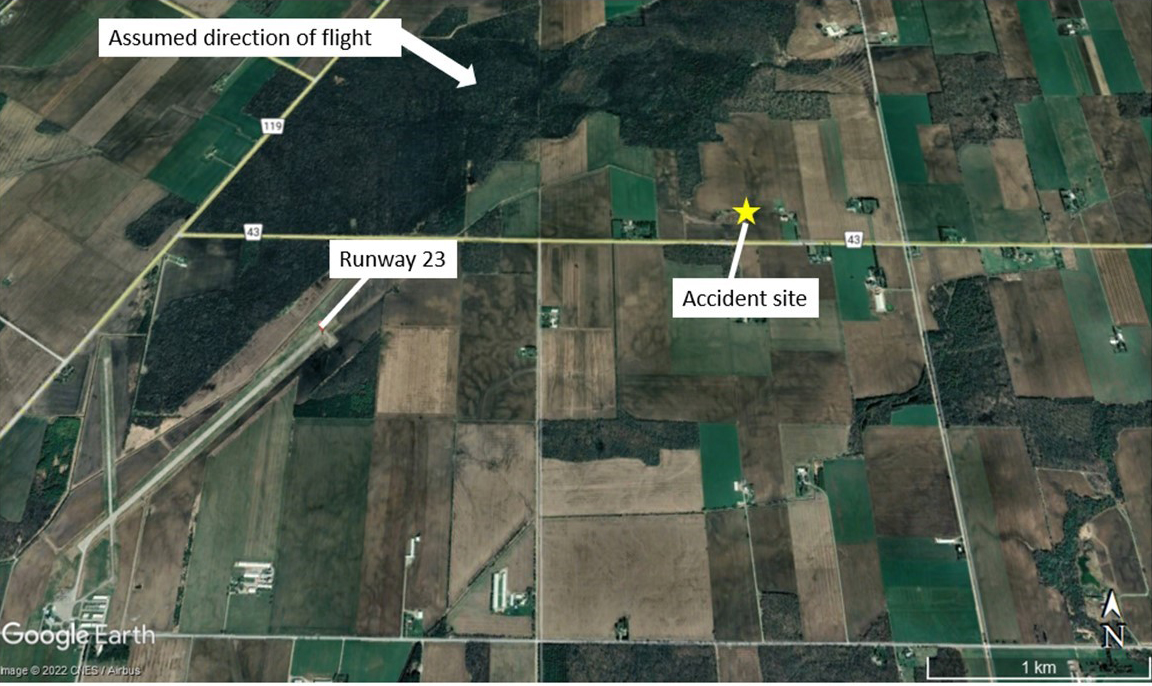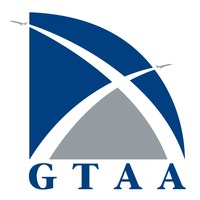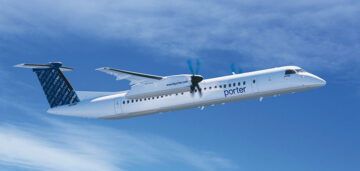
Richmond Hill, Ontario, 2 March 2023 — Today, the Transportation Safety Board of Canada (TSB) released its investigation report (A22O0125) into the 23 August 2022 fatal collision with terrain of a privately registered Grumman G44 Widgeon aircraft at the Stratford Municipal Airport, Ontario.
The TSB conducted a limited-scope, class 4 investigation into this occurrence to advance transportation safety through greater awareness of potential safety issues. See the Policy on Occurrence Classification for more information.
The TSB is an independent agency that investigates air, marine, pipeline, and rail transportation occurrences. Its sole aim is the advancement of transportation safety. It is not the function of the Board to assign fault or determine civil or criminal liability.
Collision with terrain
Privately registered
Grumman Aircraft Engineering Corp. G44 (Widgeon), C-FNGD
Stratford Municipal Airport, Ontario, 1.3 NM ENE
23 August 2022
History of the flight
At approximately 0830Footnote1 on 23 August 2022, the privately registered Grumman Aircraft Engineering Corp. G44 (Widgeon) aircraft (registration C-FNGD, serial number 1210) departed Sarnia (Chris Hadfield) Airport (CYZR), Ontario, for a visual flight rules (VFR) flight to Stratford Municipal Airport (CYSA), Ontario. The pilot was alone on board. The purpose of the flight was to bring the aircraft to a maintenance facility at CYSA to have an annual inspection performed.
The cruise portion of the flight was conducted at about 3000 feet above sea level and the aircraft approached CYSA from the southwest. The pilot’s last radio transmission on the CYSA aerodrome traffic frequency (122.8 MHz) indicated that he was turning onto the right base leg for Runway 23.
At about 0910, the aircraft was observed flying in low-visibility conditions, entering and exiting areas of low cloud cover in a steep right angle of bank. The aircraft then disappeared from sight and, a few seconds later, an impact sound was heard. Although the actual impact was not observed, smoke from the fire could be seen from a nearby field, and observers called 911. The aircraft had crashed in a cultivated field, 1.3 nautical miles (NM) east-northeast of the Runway 23 threshold (Figure 1). There was a significant post-impact fire and the aircraft was destroyed. The pilot was fatally injured.

Pilot information
The pilot held the appropriate licence for the planned flight in accordance with existing regulations. He held a private pilot licence – aeroplane and a valid Category 3 medical certificate. His licence was endorsed with a VFR over-the-top rating; he did not hold an instrument rating. The pilot had accumulated approximately 1146 hours total flying time, 133.6 hours of which were on the occurrence aircraft, including 26.8 hours in the last 12 months. Over the last 90 days, he had flown a total of 2.8 hours.
Weather information
The weather at CYZR before departure was suitable for VFR flight. The 0800 automated weather observation system (AWOS) report at CYZR showed the visibility was 9 statute miles (SM) with no clouds, the temperature was 19°C and dew point 17°C. The 0900 AWOS report indicated similar conditions. There is no weather reporting available at CYSA; however, local observers reported the weather as poor visibility, low ceilings with fog at the airport and surrounding area.
Weather reports for nearby airports indicated the following:
- At 0800, the Kitchener/Waterloo Airport (CYKF), Ontario, AWOS (24 NM east of the accident site) indicated a visibility of 9 SM, overcast ceiling at 8100 feet, temperature 18°C, and dew point 17°C. Similar conditions were reported at 0900.
- At 0800, the London Airport (CYXU), Ontario, aerodrome routine meteorological report (METAR) (25 NM south-southwest of the accident site) indicated a visibility of ½ SM in fog and a broken ceiling at 100 feet, temperature and dew point were both 18°C. At 0900, the METAR indicated a visibility of 10 SM, scattered clouds at 600 feet and 8000 feet, temperature and dewpoint were both 20°C.
The investigation was unable to determine what weather information the pilot had reviewed before the flight.
Aircraft information
The Grumman Aircraft Engineering Corp. G44 (Widgeon) is a high-wing, twin-engine, flying boat amphibious aircraft, equipped with 6 seats. The occurrence aircraft was manufactured in 1941, and was retrofitted with Teledyne Continental IO-470-E engines and McCauley 3AF32C528/82 NEA-4 constant speed propellers. The aircraft had accumulated approximately 3226 hours of total air time before the occurrence.
Aerodynamic stall
An aerodynamic stall occurs when a wing’s angle of attack exceeds the critical angle at which the airflow begins to separate. When a wing stalls, the airflow breaks away from the upper surface and the amount of lift is reduced to below that needed to keep the wing flying. While stalls occur at a given angle of attack, they can happen at any speed. The speed at which a stall occurs depends on a number of things, including the load factor, the weight of the aircraft, and the centre of gravity.
Increasing the angle of bank increases the load factor and the aircraft’s stalling speed because it causes the aircraft to perform as if it is heavier. At a 60° angle of bank, the load factor is 2, meaning that the aircraft performs as if it is twice as heavy as it would be in level flight. The stall speed is increased by about 40% at a 60° angle of bank. At a 45° angle of bank, the load factor is 1.4 and the stall speed is increased by about 18%. The investigation was unable to determine the aircraft’s actual speed during the flight or during the steep turn that was observed shortly before the accident.
Wreckage information
The disposition of the wreckage at the accident site and lack of wreckage trail indicate that the aircraft struck the ground in a nearly vertical attitude. The 2 propellers were embedded in the ground and the wing leading edges were crushed rearward by impact forces. The damage to the propellers is consistent with the engines producing power at impact. A post-impact fire consumed the entire fuselage. The wings and flight controls were also damaged in the fire, which prevented verification of flight control continuity.
The aircraft was not equipped with a lightweight data recorder, nor was it required to be by regulation. Given the absence of data, the investigation could not determine the complete sequence of events that led to the collision with terrain.
This report concludes the Transportation Safety Board of Canada’s investigation into this occurrence. The Board authorized the release of this report on 22 February 2023. It was officially released on 02 March 2023.
- SEO Powered Content & PR Distribution. Get Amplified Today.
- Platoblockchain. Web3 Metaverse Intelligence. Knowledge Amplified. Access Here.
- Source: https://canadianaviationnews.wordpress.com/2023/03/04/tsb-investigation-report-fatal-collision-with-terrain-at-stratford-municipal-airport-ontario/
- 1
- 1.3
- 2022
- a
- About
- above
- accident
- Accumulated
- advance
- advancement
- agency
- AIR
- aircraft
- airport
- Airports
- alone
- Although
- amount
- and
- annual
- appropriate
- approximately
- AREA
- areas
- assumed
- attack
- attitude
- AUGUST
- Automated
- available
- awareness
- Bank
- base
- because
- before
- below
- board
- boat
- breaks
- bring
- Broken
- called
- Canada
- causes
- ceiling
- centre
- certificate
- Chris
- Cloud
- complete
- conditions
- conducted
- consistent
- constant
- consumed
- continental
- control
- controls
- Corp
- could
- cover
- Crashed
- Criminal
- critical
- cruise
- data
- Days
- depends
- destination
- destroyed
- Determine
- DID
- direction
- during
- earth
- East
- embedded
- Engineering
- Engines
- Entire
- equipped
- events
- exceeds
- existing
- Exiting
- Facility
- Feet
- few
- field
- Files
- Fire
- flight
- flying
- Fog
- following
- Forces
- Frequency
- from
- function
- given
- gravity
- greater
- Ground
- happen
- heard
- heavy
- Held
- hold
- HOURS
- However
- HTML
- HTTPS
- Impact
- in
- Including
- increased
- Increases
- independent
- indicate
- indicated
- information
- instrument
- investigates
- investigation
- issues
- IT
- Keep
- Lack
- Last
- leading
- Led
- Level
- Licence
- lightweight
- load
- local
- London
- Low
- maintenance
- manufactured
- map
- March
- Marine
- max-width
- meaning
- medical
- months
- more
- municipal
- nearly
- needed
- number
- Officially
- Ontario
- perform
- performs
- pilot
- pipeline
- planned
- plato
- Plato Data Intelligence
- PlatoData
- Point
- poor
- potential
- power
- private
- purpose
- Radio
- Rail
- rating
- Reduced
- registered
- Registration
- Regulation
- regulations
- relation
- release
- released
- report
- Reported
- Reporting
- Reports
- required
- reviewed
- rules
- runway
- Safety
- scattered
- SEA
- Sea level
- seconds
- separate
- Sequence
- serial
- Shortly
- Sight
- significant
- similar
- similar conditions
- site
- Smoke
- Sound
- Source
- speed
- stalling
- suitable
- Surface
- Surrounding
- system
- The
- things
- threshold
- Through
- time
- to
- today
- Total
- traffic
- transportation
- TSB
- TURN
- Turning
- Twice
- Verification
- visibility
- Weather
- weight
- What
- which
- while
- Wing
- WordPress
- would
- zephyrnet












